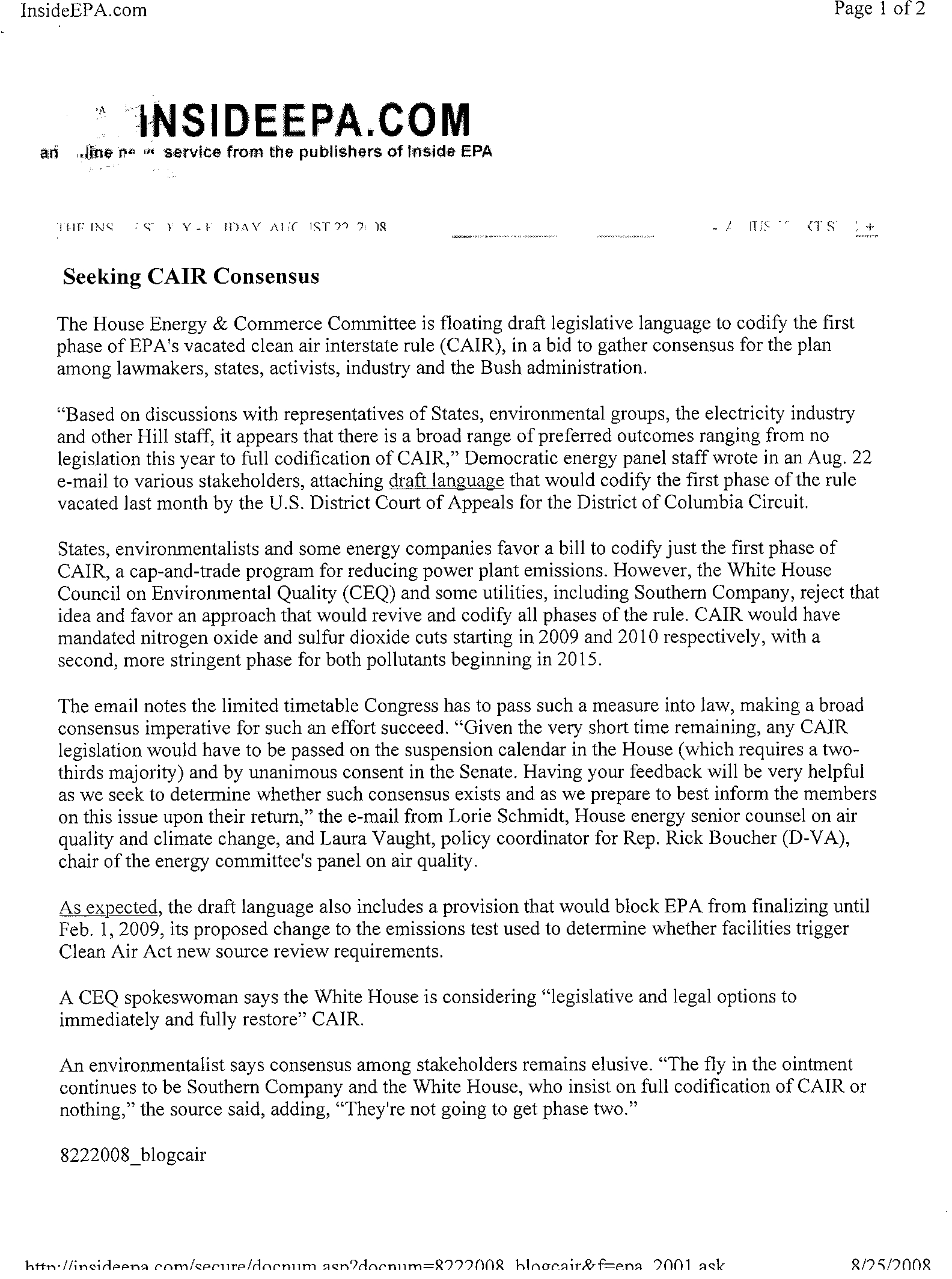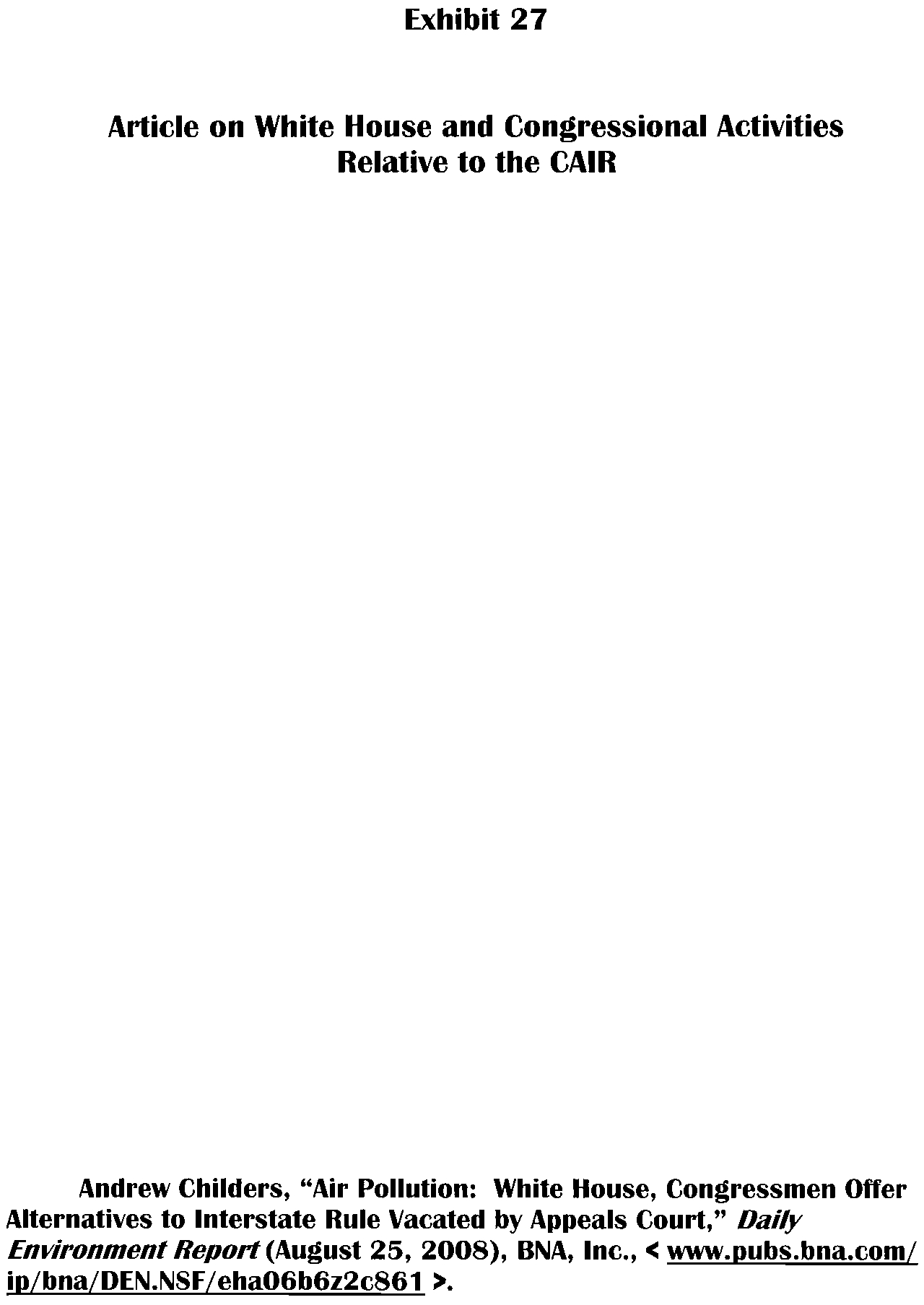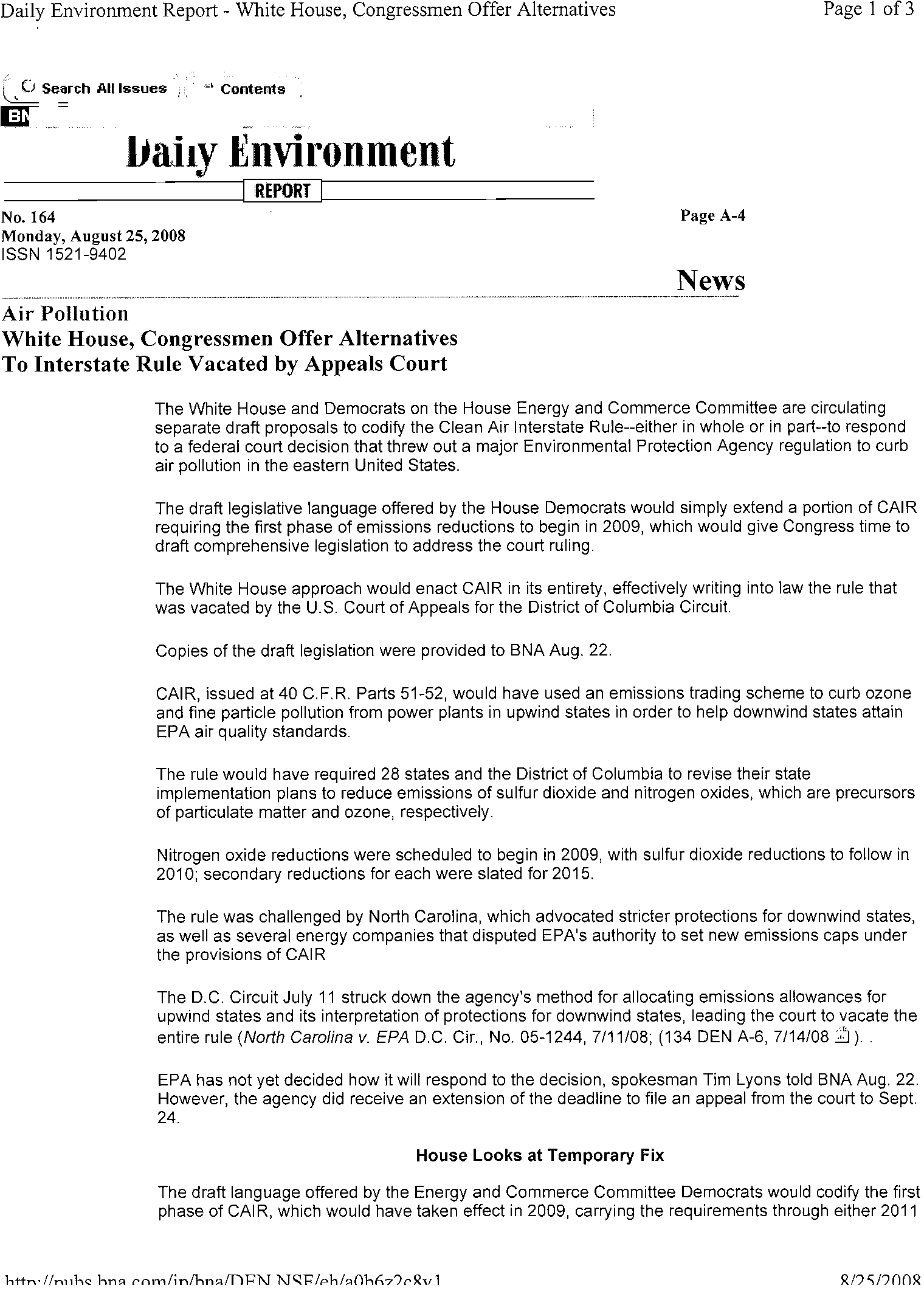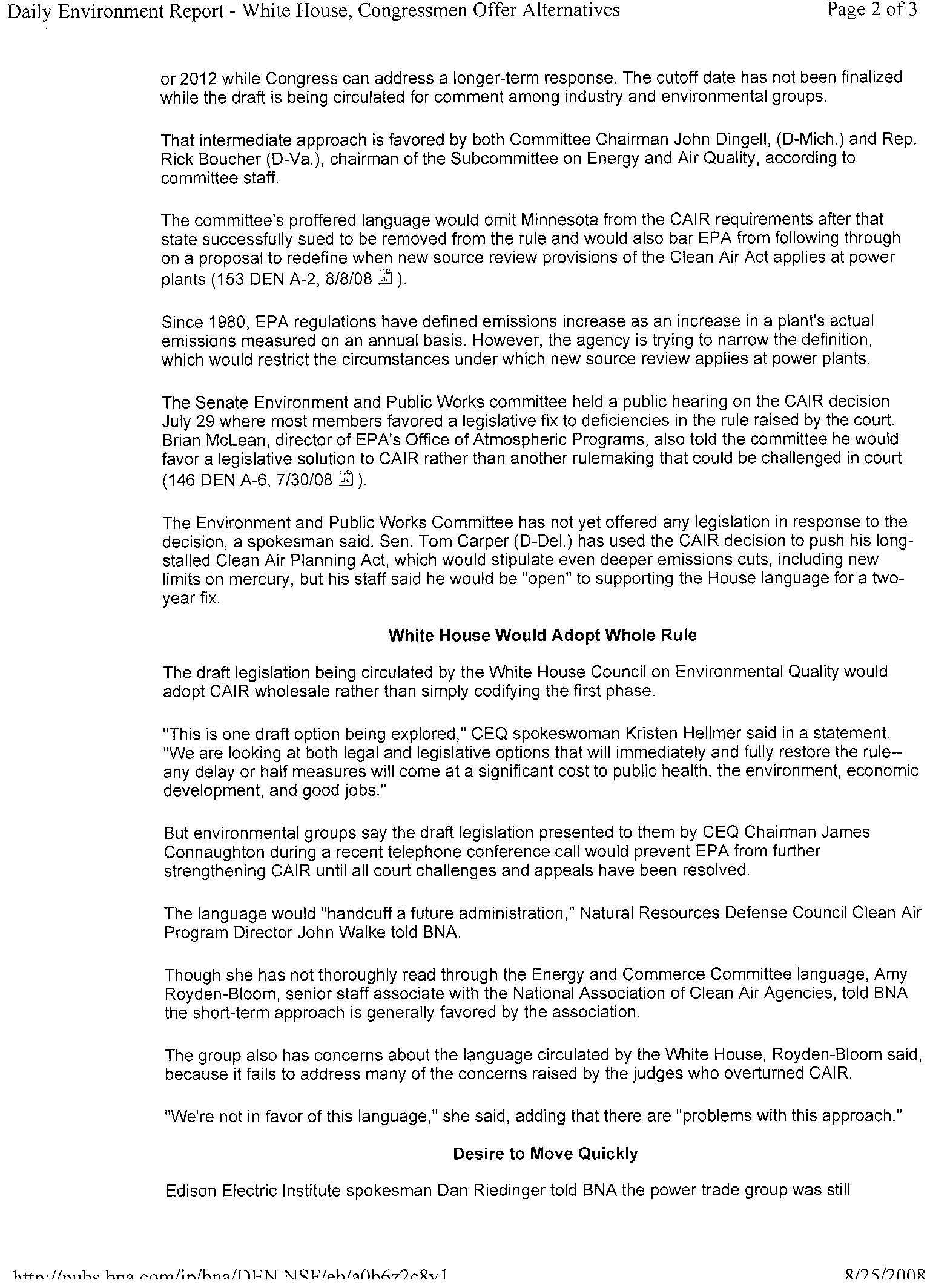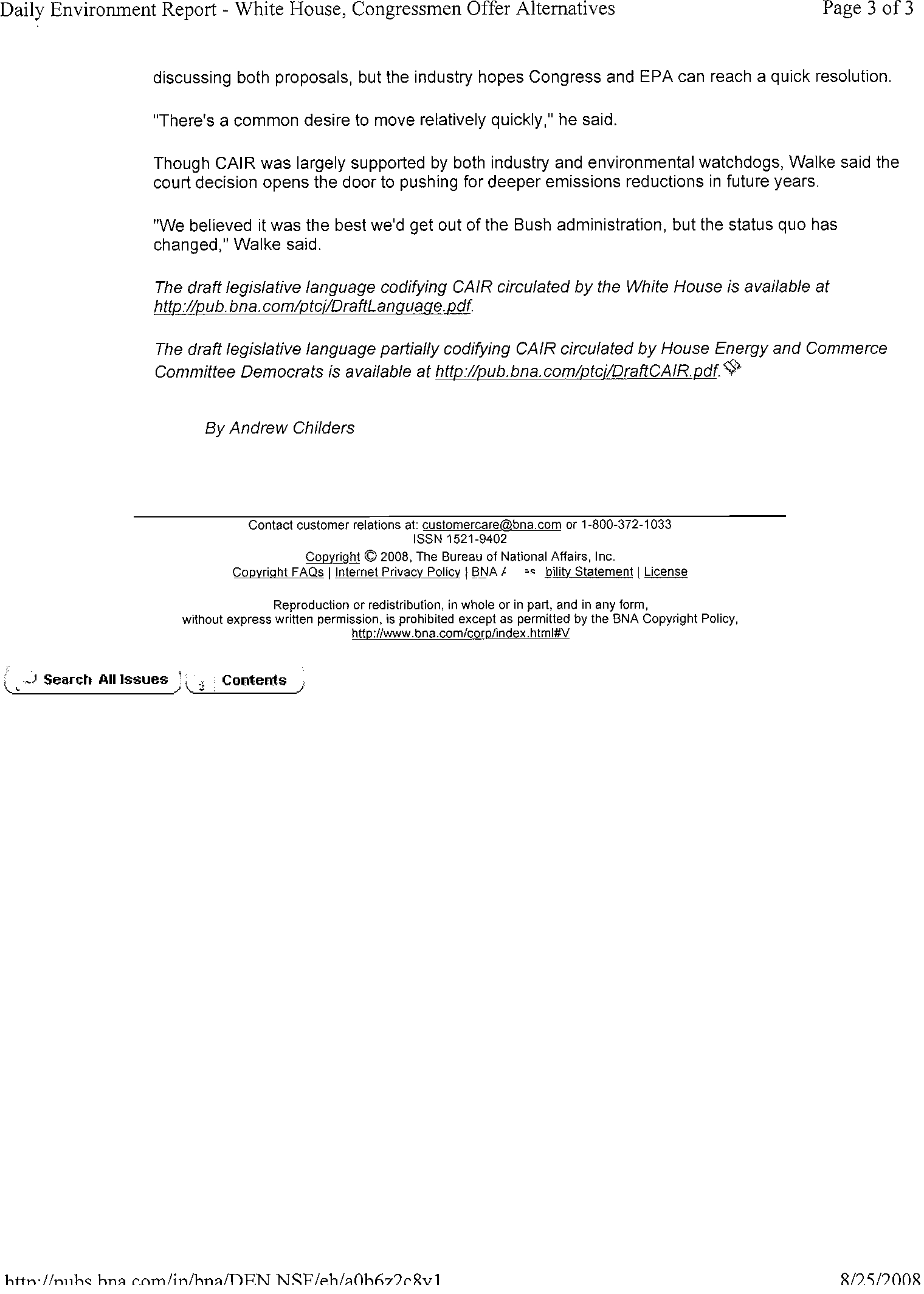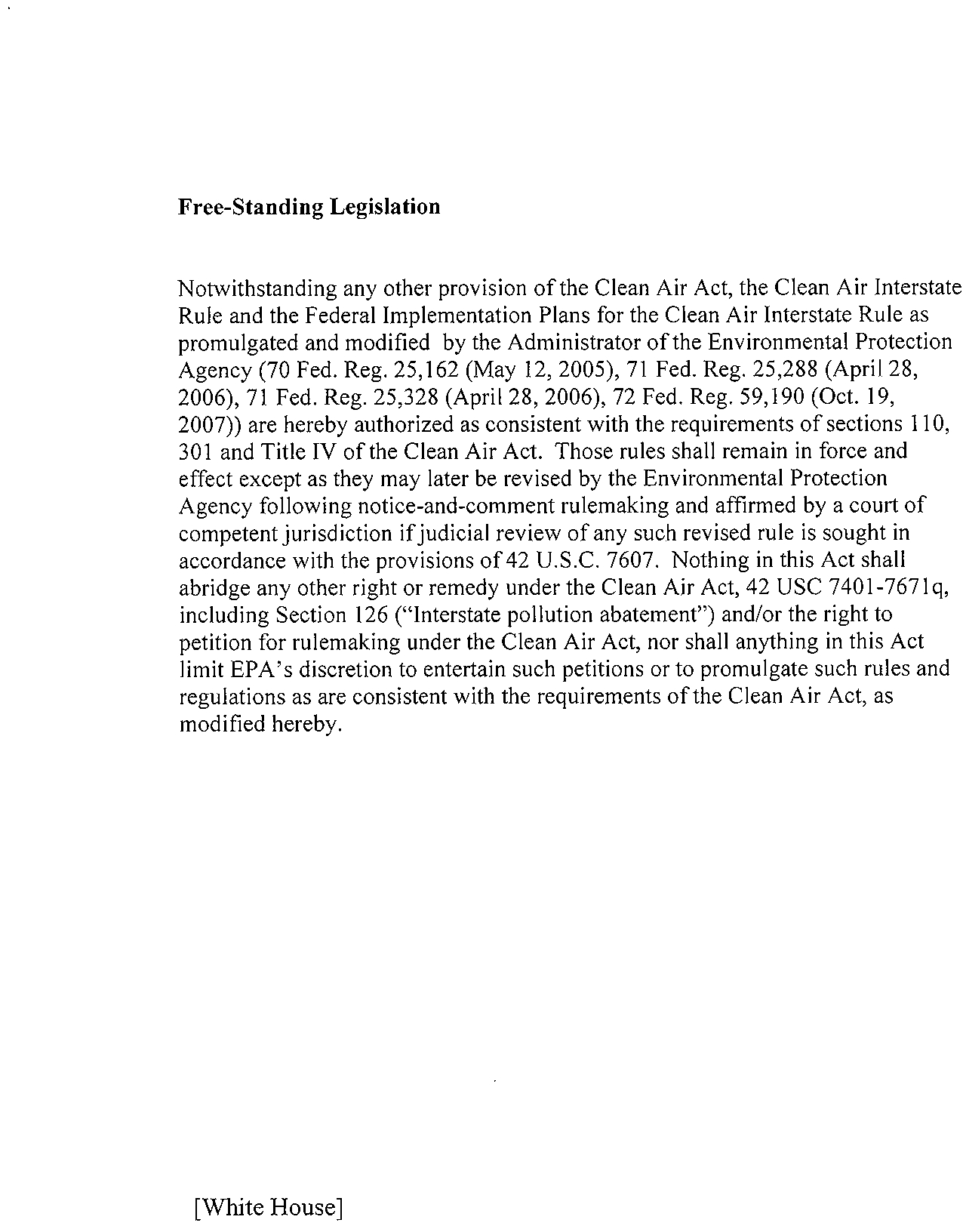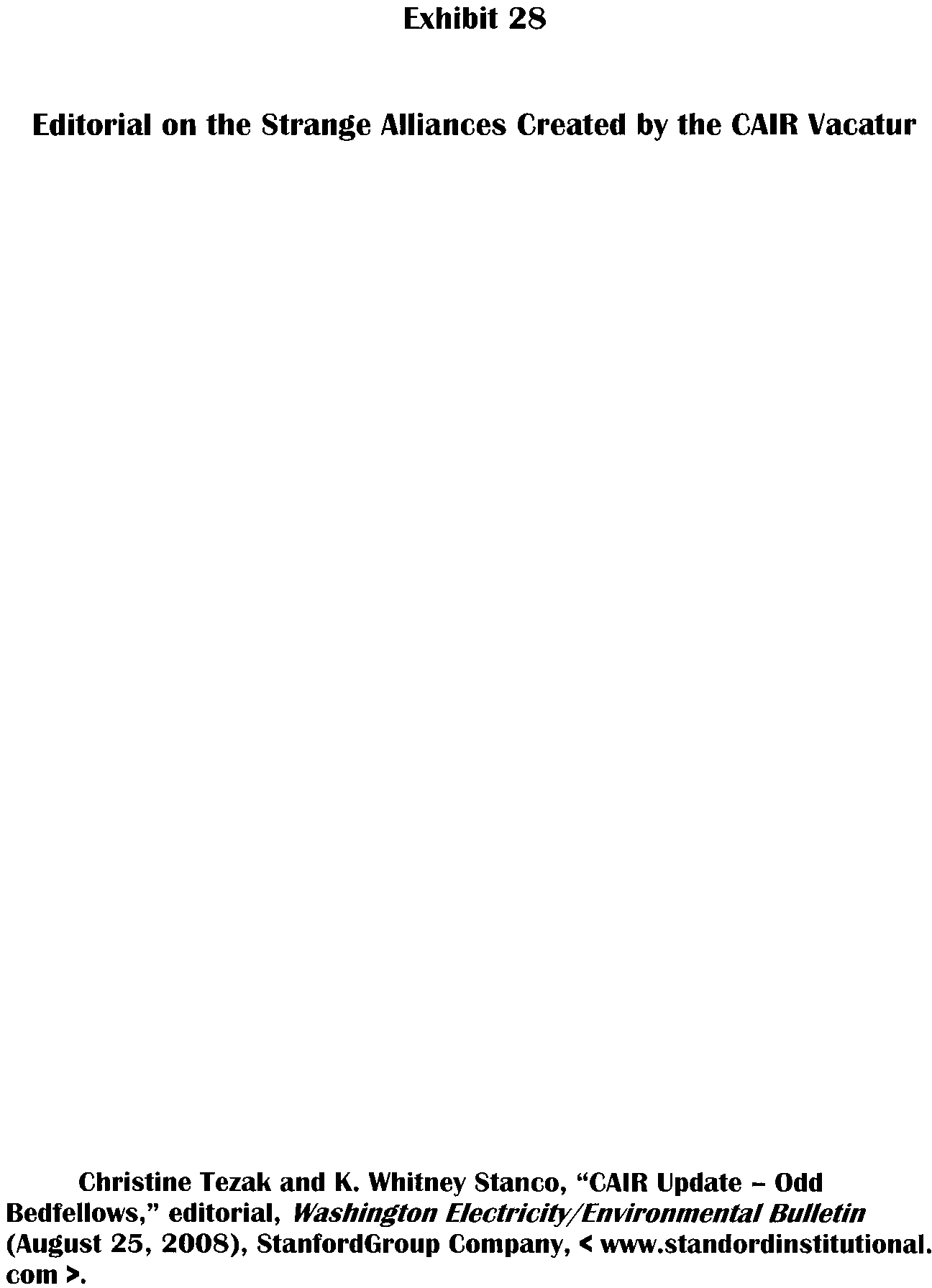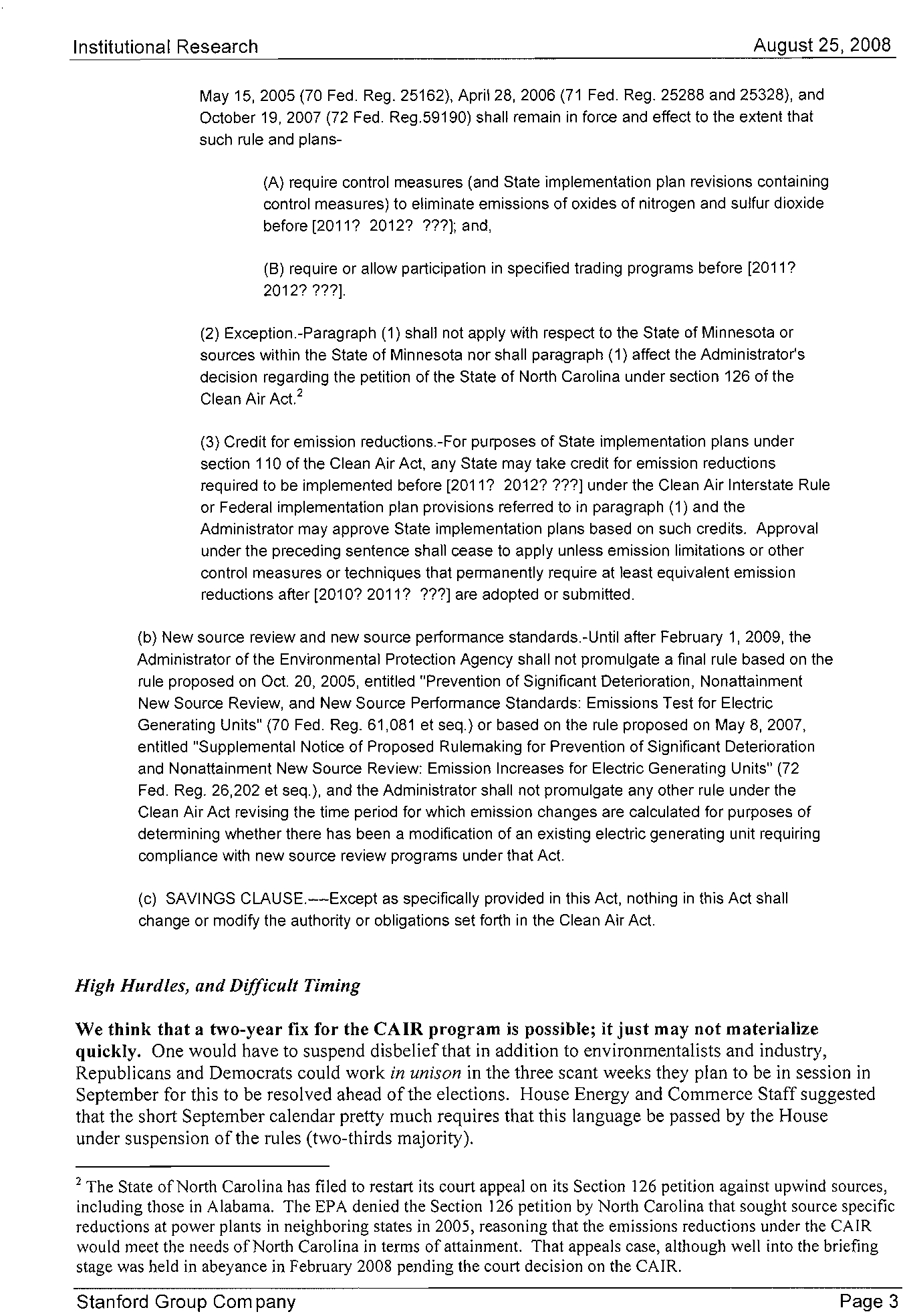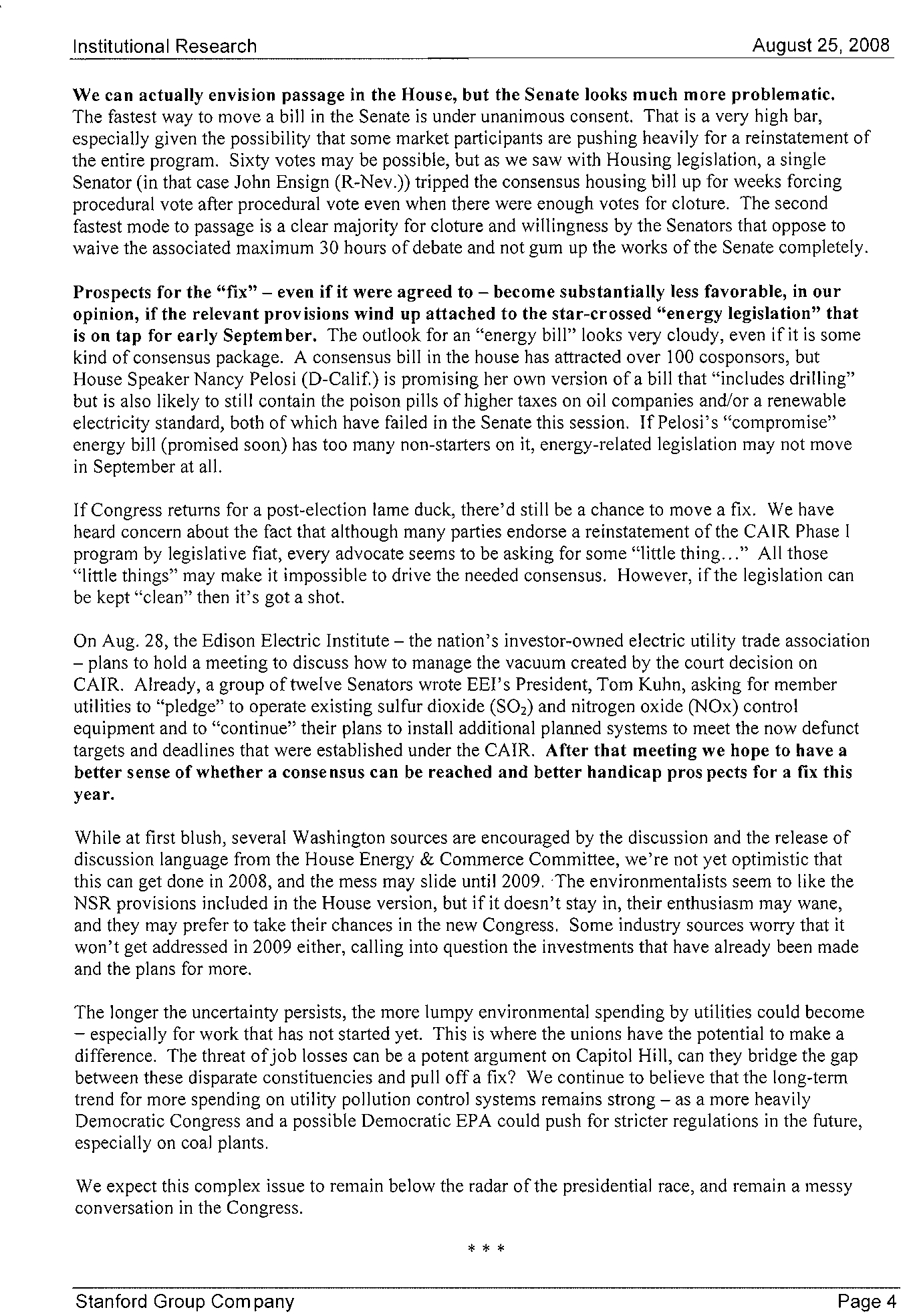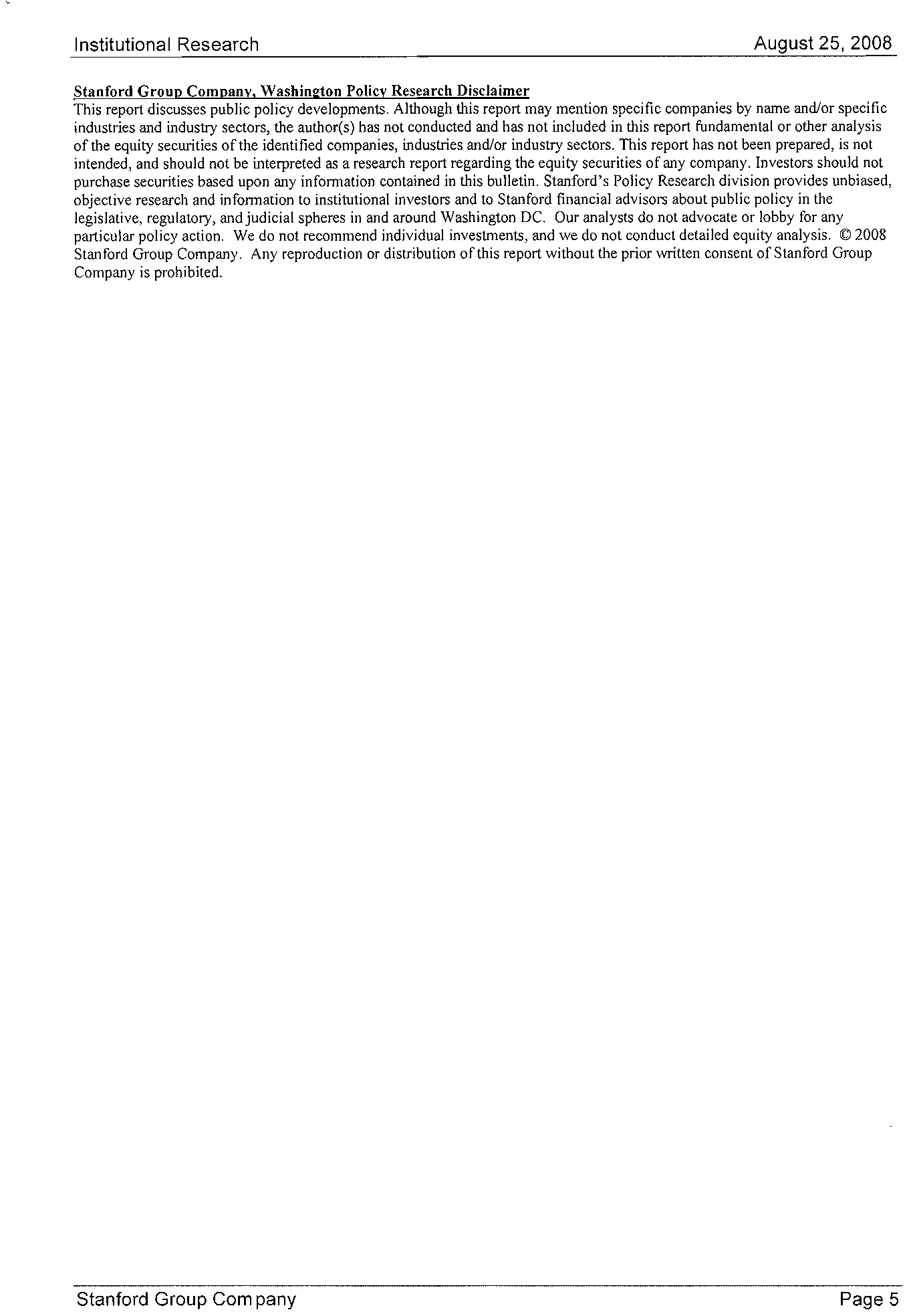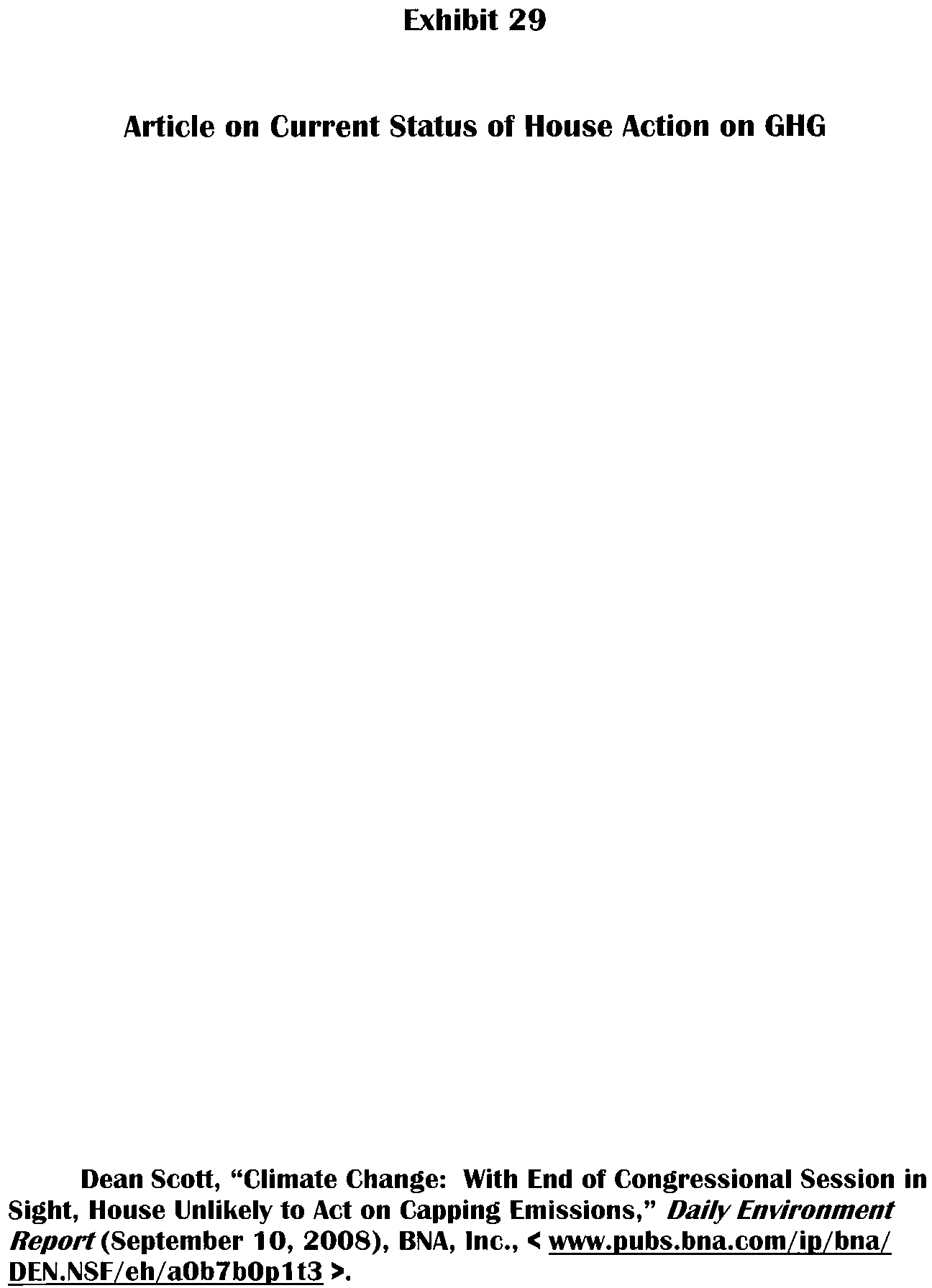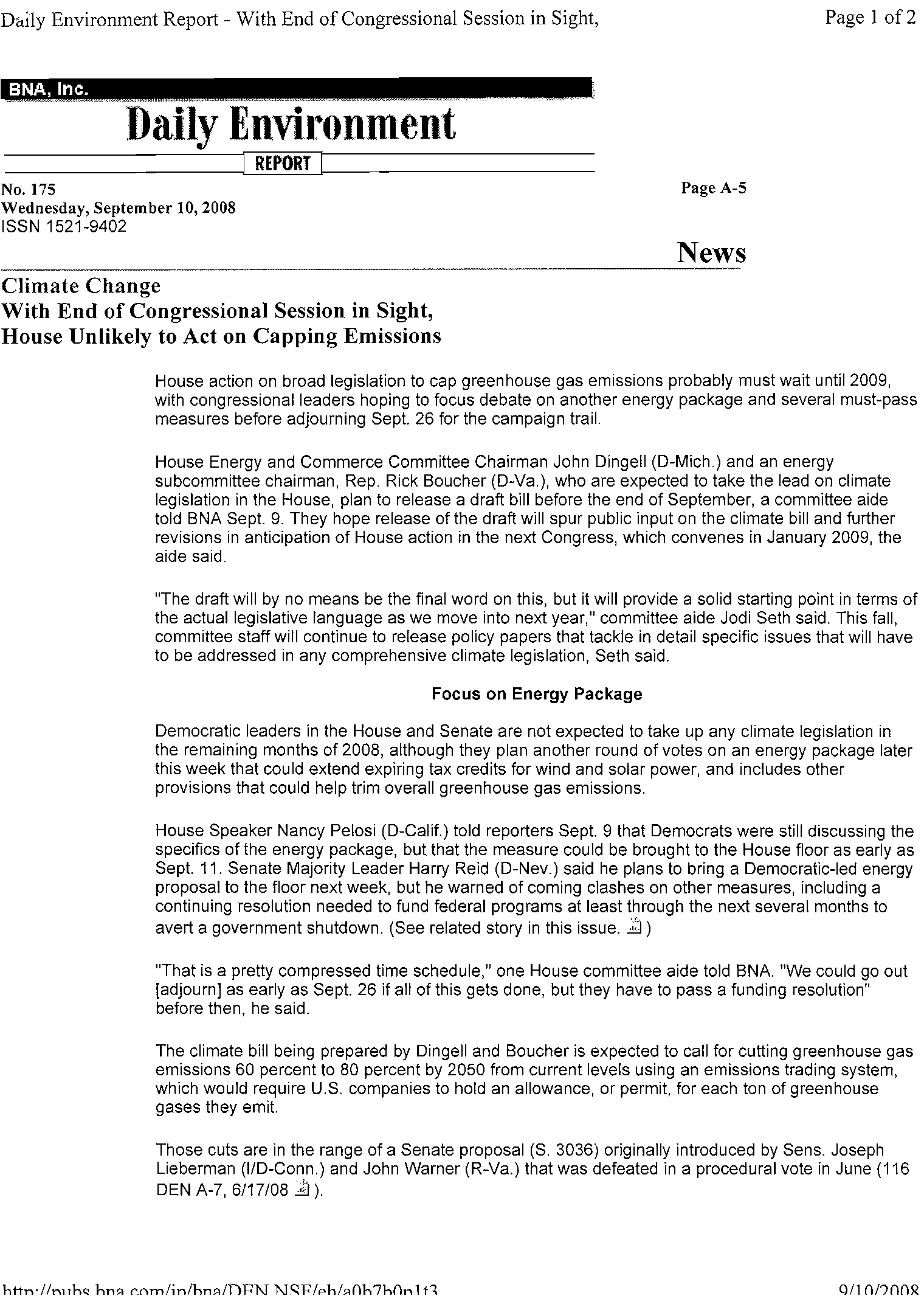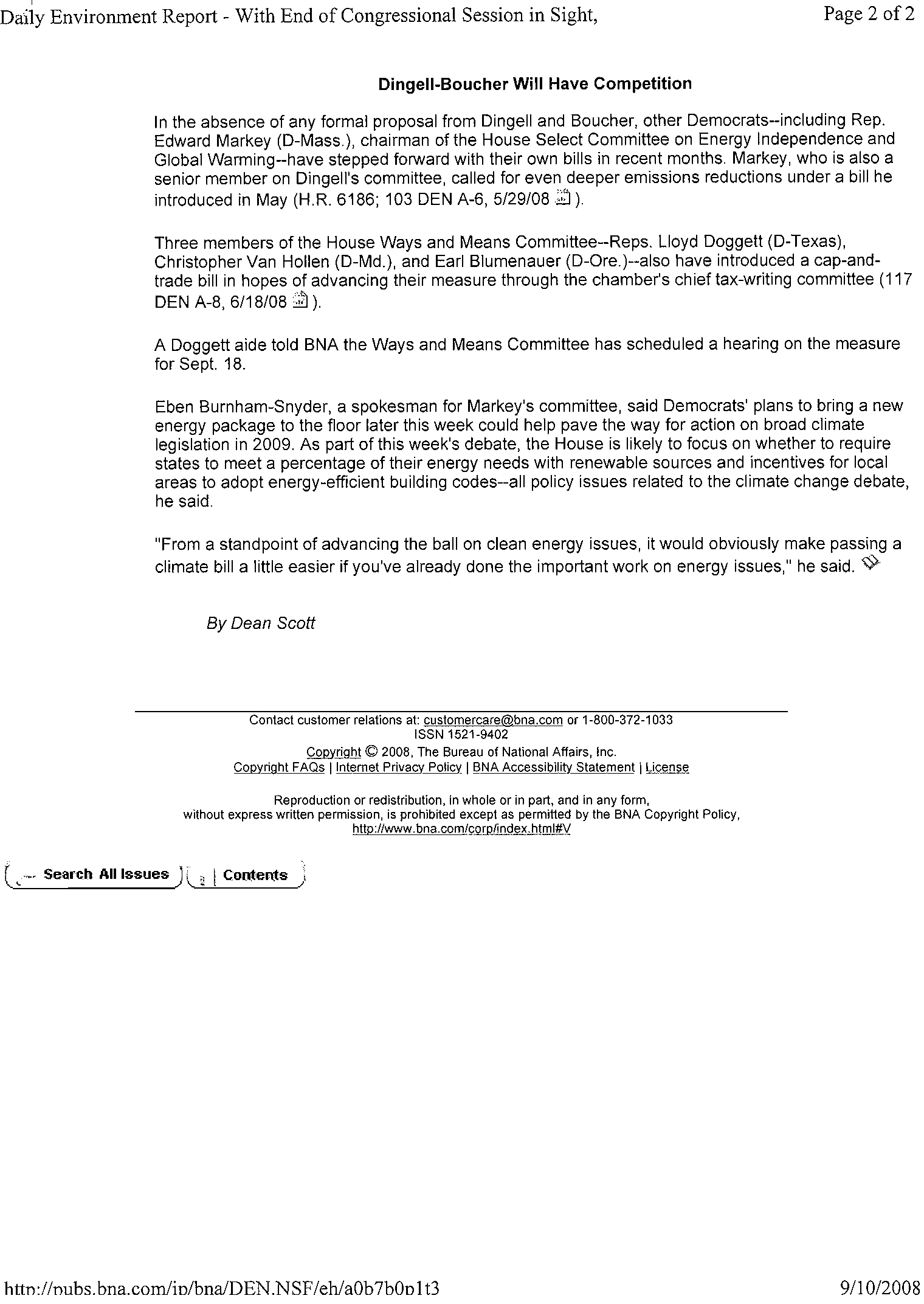"Seeking
CAIR
Consensus,"
InsideEPA.com
(August
22,
2008),
<
www.insideepa.com/secure/docnum.asp?docnum=8222008
blogcair&f
=epa
2001.
ask
>.
Electronic Filing - Received, Clerk's Office, October 1, 2008
* * * * * PCB 2009-021 * * * * *
Seeking
CAIR
Consensus
The
House
Energy
&
Commerce
Committee
is
floating
draft
legislativelanguage
to
codify
the
first
phase
of
EPA's
vacated
clean
air
interstate
rule
(CAIR),
in
a
bid
to
gather
consensus
for
the
plan
among
lawmakers,
states,
activists,
industry
and
the
Bush
administration.
"Based
on
discussions
with
representatives
of
States,
environmental
groups,
the
electricity
industry
and
other
Hill
staff,
it
appears
that
there
is
a
broad
range
of
preferred
outcomes
ranging
from
no
legislation
this
year
to
full
codification
ofCAIR,"
Democratic
energy
panel
staff
wrote
in
an
Aug.
22
e-mail
to
various
stakeholders,
attaching
draft
lanIDill~
that
would
codify
the
first
phase
of
the
rule
vacated
last
month
by
the
U.S.
District
Court
of
Appeals
for
the
District
of
Columbia
Circuit.
States,
environmentalists
and
some
energy
companies
favor
a
bill
to
codify
just
the
first
phase
of
CAIR,
a
cap-and-trade
program
for
reducing
power
plant
emissions.
However,
the
White
House
Council
on
Environmental
Quality
(CEQ)
and
some
utilities,
including
Southern
Company,
reject
that
idea
and
favor
an
approach
that
would
revive
and
codify
all
phases
of
the
rule.
CAIR
would
have
mandated
nitrogen
oxide
and
sulfur
dioxide
cuts
starting
in
2009
and
2010
respectively,
with
a
second,
more
stringent
phase
for
both
pollutants
beginning
in
2015.
The
email
notes
the
limited
timetable
Congress
has
to
pass
such
a
measure
into
law,
making
a
broad
consensus
imperative
for
such
an
effort
succeed.
"Given
the
very
short
time
remaining,
any
CAIR
legislation
would
have
to
be
passed
on
the
suspension
calendar
in
the
House
(which
requires
a
two-
thirds
majority)
and
by
unanimous
consent
in
the
Senate.
Having
your
feedback
will
be
very
helpful
as
we
seek
to
determinewhether
such
consensus
exists
and
as
we
prepare
to
best
inform
the
members
on
this
issue
upon
their
return,"
the
e-mail
from
Lorie
Schmidt,
House
energy
senior
counsel
on
air
quality
and
climate
change,
and
Laura
Vaught,
policy
coordinator
for
Rep.
Rick
Boucher
(D-VA),
chair
of
the
energy
committee's
panel
on
air
quality.
As
eXIlected,
the
draft
language
also
includes
a
provision
that
would
block
EPA
from
finalizing
until
Feb.
1,2009,
its
proposed
change
to
the
emissions
test
used
to
determine
whether
facilities
trigger
Clean
Air
Act
new
source
review
requirements.
A
CEQ
spokeswoman
says
the
White
House
is
considering
"legislative
and
legal
options
to
immediately
and
fully
restore"
CAIR.
An
environmentalist
says
consensus
among
stakeholders
remains
elusive.
"The
fly
in
the
ointment
continues
to
be
Southern
Company
and
the
White
House,
who
insist
on
full
codification
of
CAIR
or
nothing,"
the
source
said,
adding,
"They're
not
going
to
get
phase
two."
8222008_
blogcair
Electronic Filing - Received, Clerk's Office, October 1, 2008
* * * * * PCB 2009-021 * * * * *
R/?~/?OOR
Electronic Filing - Received, Clerk's Office, October 1, 2008
* * * * * PCB 2009-021 * * * * *
Andrew
Childers,
"Air
Pollution:
White
House,
Congressmen
Offer
Alternatives
to
Interstate
Rule
Vacated
by
Appeals
Court,"
Daily
En~ironment
Report
(August
25,
2008),
RNA,
Inc.,
<
www.pubs.bna.com/
ip/bna/DEN.NSF/eha06b6z2c861
>.
Electronic Filing - Received, Clerk's Office, October 1, 2008
* * * * * PCB 2009-021 * * * * *
Air
Pollution
White
House,
Congressmen
Offer
Alternatives
To
Interstate
Rule
Vacated
by
Appeals
Court
News
The
White
House
and
Democrats
on
the
House
Energy
and
Commerce
Committee
are
circulating
separate
draft
proposals
to
codify
the
Clean
Air
Interstate
Rule--either
in
whole
or
in
part--torespond
to
a
federal
court
decision
that
threw
out
a
major
Environmental
Protection
Agency
regulation
to
curb
air
pollution
in
the
eastern
United
States.
The
draft
legislative
language
offered
by
the
House
Democrats
would
simply
extend
a
portion
of
CAIR
requiring
the
first
phase
of
emissions
reductions
to
begin
in
2009,
which
would
give
Congress
time
to
draft
comprehensive
legislation
to
address
the
court
ruling.
The
White
House
approach
would
enact
CAIR
in
its
entirety,
effectively
writing
into
law
the
rule
that
was
vacated
by
the
U.S
Court
of
Appeals
for
the
District
of
Columbia
Circuit.
Copies
of
the
draft
legislation
were
provided
to
BNA
Aug.
22.
CAIR,
issued
at
40
C.F.R.
Parts
51-52,
would
have
used
an
emissions
trading
scheme
to
curb
ozone
and
fine
particle
pollution
from
power
plants
in
upwind
states
in
order
to
help
downwind
states
attain
EPA
air
quality
standards.
The
rule
would
have
required
28
states
and
the
District
of
Columbia
to
revise
their
state
implementation
plans
to
reduce
emissions
of
sulfur
dioxide
and
nitrogen
oxides,
which
are
precursors
of
particulate
matter
and
ozone,
respectively.
Nitrogen
oxide
reductions
were
scheduled
to
begin
in
2009,
with
sulfur
dioxide
reductions
to
follow
in
2010;
secondary
reductions
for
each
were
slated
for
2015.
The
rule
was
challenged
by
North
Carolina,
which
advocated
stricter
protections
for
downwind
states,
as
well
as
several
energy
companies
that
disputed
EPA's
authority
to
set
new
emissions
caps
under
the
provisions
of
CAl
R
The
D.C.
Circuit
July
11
struck
down
the
agency's
method
for
allocating
emissions
allowances
for
upwind
states
and
its
interpretation
of
protections
for
downwind
states,
leading
the
court
to
vacate
the
entire
rule
(North
Carolina
v.
EPA
D.C.
Cir.,
No.
05-1244,
7/11/08;
(134
DEN
A-5,
7/14/08
2i).
EPA
has
not
yet
decided
how
it
will
respond
to
the
decision,
spokesman
Tim
Lyons
told
BNA
Aug.
22.
However,
the
agency
did
receive
an
extension
of
the
deadline
to
file
an
appeal
from
the
court
to
Sept.
24.
House
Looks
at
Temporary
Fix
The
draft
language
offered
by
the
Energy
and
Commerce
Committee
Democrats
would
codify
the
first
phase
of
CAIR,
which
would
have
taken
effect
in
2009,
carrying
the
requirements
through
either
2011
Electronic Filing - Received, Clerk's Office, October 1, 2008
* * * * * PCB 2009-021 * * * * *
plants
(153
DEN
A-2,
8/8/08
~).
Since
1980,
EPA
regulations
have
defined
emissions
increase
as
an
increase
in
a
plant's
actual
emissions
measured
on
an
annual
basis.
However,
the
agency
is
trying
to
narrow
the
definition,
which
would
restrict
the
circumstances
under
which
new
source
review
applies
at
power
plants.
The
Senate
Environment
and
Public
Works
committee
held
a
public
hearing
on
the
CAIR
decision
July
29
where
most
members
favored
a
legislative
fix
to
deficiencies
in
the
rule
raised
by
the
court.
Brian
McLean,
director
of
EPA's
Office
of
Atmospheric
Programs,
also
told
the
committee
he
would
favor
a
legislative
solution
to
CAIR
rather
than
another
rulemaking
that
could
be
challenged
in
court
(146
DEN
A-6,
7/30108
~).
The
Environment
and
Public
Works
Committee
has
not
yet
offered
any
legislation
in
response
to
the
decision,
a
spokesman
said.
Sen.
Tom
Carper
(D-Del.)
has
used
the
CAIR
decision
to
push
his
long-
stalled
Clean
Air
Planning
Act,
which
would
stipulate
even
deeper
emissions
cuts,
including
new
limits
on
mercury,
but
his
staff
said
he
would
be
"open"
to
supporting
the
House
language
for
a
two-
year
fix.
White
House
Would
Adopt
Whole
Rule
The
draft
legislation
being
circulated
by
the
White
House
Council
on
Environmental
Quality
would
adopt
CAIR
wholesale
rather
than
simply
codifying
the
first
phase.
"This
is
one
draft
option
being
explored,"
CEQ
spokeswoman
Kristen
Hellmer
said
in
a
statement.
"We
are
looking
at
both
legal
and
legislative
options
that
will
immediately
and
fully
restore
the
rule-
any
delay
or
half
measures
will
come
at
a
significant
cost
to
public
health,
the
environment,
economic
development,
and
good
jobs."
But
environmental
groups
say
the
draft
legislation
presented
to
them
by
CEQ
Chairman
James
Connaughton
during
a
recent
telephone
conference
call
would
prevent
EPA
from
further
strengthening
CAIR
until
all
court
challenges
and
appeals
have
been
resolved.
The
language
would
"handcuff
a
future
administration,"
Natural
Resources
Defense
Council
Clean
Air
Program
Director
John
Walke
told
BNA.
Though
she
has
not
thoroughly
read
through
the
Energy
and
Commerce
Committee
language,
Amy
Royden-Bloom,
senior
staff
associate
with
the
National
Association
of
Clean
Air
Agencies,
told
BNA
the
short-term
approach
is
generally
favored
by
the
association.
The
group
also
has
concerns
about
the
ianguage
circulated
by
the
White
House,
Royden-Bloom
said,
because
it
fails
to
address
many
of
the
concerns
raised
by
the
judges
who
overturned
CAIR.
"We're
not
in
favor
of
this
language,"
she
said,
adding
that
there
are
"problems
with
this
approach."
Desire
to
Move
Quickly
Edison
Electric
Institute
spokesman
Dan
Riedinger
told
BNA
the
power
trade
group
was
still
Electronic Filing - Received, Clerk's Office, October 1, 2008
* * * * * PCB 2009-021 * * * * *
The
draft
legislative
language
codifying
CAIR
circulated
by
the
White
House
is
available
at
http':I/p'ub.bna.com/p.tcilDraftLanguage.p'df.
The
draft
legislative
language
partially
codifying
CAIR
circulated
by
House
Energy
and
Commerce
Committee
Democrats
is
available
at
http'.'//p'ub.bna.com/P.Js;j/DraftCAIR.p'df.
~
By
Andrew
Childers
Contact
customer
relations
at:
customercare@bna.com
or
1-800-372-1033
ISSN
1521.9402
COQYi!Qh!
©
2008,
The
Bureau
of
National
Affairs,
Inc.
CoQY!jght
FAQs
I
Internet
Privacy
Policy
I
BNA
AccessibilitY.
Statement
I
License
Reproduction
or
redistribution.
in
whole
or
in
part,
and
in
any
form,
without
express
written
permission,
is
prohibited
except
as
permitted
by
the
BNA
Copyright
Policy,
IillR
:/Iwww.bna.com/corplindex.
him
I#V
(
..
CJ
Search
All
Issues
J
(~
Cameros
J
httn./lnllh<.:
hn~
('om/ln/hn::l/nFN
N~P
lp:h/::l()hh7?r,Rv
1
RI?
'iI?OOR
Electronic Filing - Received, Clerk's Office, October 1, 2008
* * * * * PCB 2009-021 * * * * *
Rule
and
the
Federal
ImplementationPlans
for
the
Clean
Air
Interstate
Rule
as
promulgated
and
modified
by
the
Administrator
of
the
Environmental
Protection
Agency
(70
Fed.
Reg.
25,162
(May
12,2005),71
Fed.
Reg.
25,288
(April
28,
2006),
71
Fed.
Reg.
25,328
(April
28,
2006),
72
Fed.
Reg.
59,190
(Oct.
19,
2007»
are
hereby
authorized
as
consistent
with
the
requirements
of
sections
110,
301
and
Title
IV
of
the
Clean
Air
Act.
Those
rules
shall
remain
in
force
and
effect
except
as
they
may
later
be
revised
by
the
Environmental
Protection
Agency
following
notice-and-comment
rulemaking
and
affirmed
by
a
court
of
competent
jurisdiction
if
judicial
review
of
any
such
revised
rule
is
sought
in
accordance
with
the
provisions
of
42
U.S.c.
7607.
Nothing
in
this
Act
shall
abridge
any
other
right
or
remedy
under
the
Clean
Air
Act,
42
USC
7401-7671q,
including
Section
126
("Interstate
pollution
abatement")
and/or
the
right
to
petition
for
rulemaking
under
the
Clean
Air
Act,
nor
shall
anything
in
this
Act
limit
EPA's
discretion
to
entertain
such
petitions
or
to
promulgate
such
rules
and
regulations
as
are
consistent
with
the
requirements
of
the
Clean
Air
Act,
as
modified
hereby.
[White
House]
Electronic Filing - Received, Clerk's Office, October 1, 2008
* * * * * PCB 2009-021 * * * * *
SECTION
1.
EPA
CAIR
rule
and
new
source
review.
(a)
Interim
legal
effect
ofCAIR
rule.-
(I)
In
general.-The
Clean
Air
Interstate
Rule
and
related
Federal
implementation
plans
promulgated
and
modified
by
the
Administrator
of
the
Environmental
Protection
Agency
on
May
15,
2005
(70
Fed.
Reg.
25
I
62),
April
28,2006
(71
Fed.
Reg.
25288
and
25328),
and
October
19,2007
(72
Fed.
Reg.59190)
shall
remain
in
force
and
effect
to
the
extent
that
such
rule
and
plans-
(A)
require
control
measures
(and
State
implementation
plan
revisions
containing
control
measures)
to
eliminate
emissions
of
oxides
of
nitrogen
and
sulfurdioxide
before
[20117
20127
777];
and
(B)
require
or
allow
participation
in
specified
trading
programs
before
[201
17
20127777].
(2)
Exception.-Paragraph
(I)
shall
not
apply
with
respect
to
the
State
of
Minnesota
or
sources
within
the
State
of
Minnesota
nor
shall
paragraph
(I)
affect
the
Administrator's
decision
regarding
the
petition
of
the
State
of
North
Carolina
under
section
126
of
the
Clean
Air
Act.
(3)
Credit
for
emission
reductions.-For
purposes
of
State
implementation
plans
under
section
I
10
of
the
Clean
Air
Act,
any
State
may
take
credit
for
emission
reductions
required
to
be
implemented
before
[20
117
20127
777]
under
the
Clean
Air
Interstate
Rule
or
Federal
implementation
plan
provisions
referred
to
in
paragraph
(I)
and
the
Administrator
may
approve
State
implementation
plans
based
on
such
credits.
Approval
under
the
preceding
sentence
shall
cease
to
apply
unless
emission
limitations
or
other
control
measures
or
techniques
that
permanently
require
at
least
equivalent
emission
reductions
after
[20
I
07
20117
777]
are
adopted
or
submitted.
[House
Energy
and
Commerce
Committee
Democrats]
Electronic Filing - Received, Clerk's Office, October 1, 2008
* * * * * PCB 2009-021 * * * * *
for
Electric
Generating
Units"
(70
Fed.
Reg.
61,081
et
seq.)
or
based
on
the
rule
proposed
on
May
8,
2007,
entitled
"Supplemental
Notice
of
Proposed
Rulemaking
for
Prevention
of
Significant
Deterioration
and
Nonallainment
New
Source
Review:
Emission
Increases
for
Electric
Generating
Units"
(72
Fed.
Reg.
26,202
et
seq.),
and
the
Administrator
shall
not
promulgate
any
other
rule
under
the
Clean
Air
Act
revising
the
time
period
for
which
emission
changes
are
calculated
for
purposes
of
determining
whether
there
has
been
a
modification
of
an
existing
electric
generating
unit
requiring
compliance
with
new
source
review
programs
under
that
Act.
(c)
SAVINGS
CLAUSE.----Except
as
specifically
provided
in
this
Act,
nothing
in
this
Act
shall
change
or
modify
the
authority
or
obligations
set
forth
in
the
Clean
Air
Act.
Electronic Filing - Received, Clerk's Office, October 1, 2008
* * * * * PCB 2009-021 * * * * *
Christine
Tezak
and
K.
Whitney
Stanco,
"CAIR
Update
-
Odd
Bedfellows,"
editorial,
Washington
Electricity/Environmental
Bulletin
(August
25,
2008),
StanfordGroup
Company,
<
www.standordinstitutional.
com
>.
Electronic Filing - Received, Clerk's Office, October 1, 2008
* * * * * PCB 2009-021 * * * * *
.
.
..
.
Christine
Tezak
/
K.
Whitney
Stanco
Washmgton
ElectricIty/EnvIronment
Bulletm
202-298-6226
CAIR
Update
-
Odd
Bedfellows
Summary:
Six
weeks
have
passed
since
the
emissions
credit
markets
were
upended
by
the
unexpected
vacatur
of
the
Bush
Administration's
Clean
Air
Interstate
Rule
(CAIR).
So
far
there
has
been
a
smattering
of
informal
meetings,
a
Senate
hearing,
an
extension
of
the
appeal
deadline
for
the
Environmental
Protection
Agency
(EPA),
revival
sought
for
a
lawsuit
held
in
abeyance,
some
lobbying
by
the
administration
and
finally,
some
legislative
language
on
the
House
side.
The
path
to
regulatory
clarity
threatens
to
be
slow
and
bumpy
for
the
electric
utility
industry
and
pollution
control
vendors.
There
are
easily
more
reasons
to
expect
that
resolution
will
be
slow
than
quick.
There
is
the
possibility
that
something
constructive
could
happen
before
Congress
recesses
before
the
elections
-
but
that
would
be
heavily
dependent
on
a
consistently
diverse
utility
industry
coming
together
with
a
plan
that
could
be
supported
by
environmental
advocates.
That
may
be
the
easy
part.
A
plan
would
need
to
win
the
support
of
two-thirds
of
the
House
and
possibly
100%
of
the
Senate.
That
is
a
very
tall
order,
and
given
partisan
election
year
politics,
rather
unlikely.
If
Congress
returns
for
a
lame
duck
session,
there
would
be
another
shot;
but,
at
this
point
we
think
it
is
far
more
likely
than
not
that
the
indnstry
slides
into
2009
with
little
change
from
today's
uncertain
status
quo.
That
being
said,
the
multi-faceted
requirements
of
the
Clean
Air
Act
across
different
programs,
combined
with
the
reality
that
states
can
drive
emissions
level
at
stationary
sources
like
utilities
are
likely
to
keep
the
focus
on
the
deployment
of
equipment
to
generate
emissions
reductions,
and
we
don't
think
that
the
short-term
uncertainty
substantially
disturbs
the
long-term
term
prospects
for
continued
investment
in
cleaner
utility
plants.
The
International
Brotherhood
of
Electric
Workers
has
been
vocal
in
Washington
oflate
about
the
short-term
disruptions
in
the
absence
ofa
fix,
and
we'll
be
watching
to
see
if
the
electric
industry
unions
can
be
the
glue
that
holds
disparate
interest
groups
together.
Strange
circumstances
create
odd
bedfellows.
Ironically,
environmentalists
and
state
regulators
are
equally
upset
by
the
Court
of
Appeals
for
the
D.C.
Circuit's
decision
to
vacate
the
Clean
Air
Interstate
Rule
as
the
utility
sector
seems
to
be.
A
path
to
resolution
will
depend
almost
exclusively
on
these
two
differentconstituencies
agreeing
in
a
way
and
in
a
consensus
they
never
have
to
date.
There
does
not
seem
any
real
alternative
short
of
the
proverbial
"act
of
Congress."
The
interest
in
a
fix
is
considerable.
Even
environmentalists
are
chagrined
to
think
that
vacatur
of
CAIR
could
suggest
that
power
plants
would
be
able
to
sidestep
planned
reductions
in
emissions,
at
least
temporarily.
Many
environmental
advocacy
groups
support
some
kind
of
"reinstatement"
of
the
CAIR
targets
for
the
Phase
I,
but
advocate
that
new
(stricter)
targets
be
developed
for
years
beyond
20
I
O.
The
original
Phase
II
of
CAIR
set
the
next
set
of
emissionsreductions
for
2015
and
the
years
that
follow.
The
EPA
was
granted
its
request
to
extend
the
Aug.
25
appeal
deadline
to
Sept.
24,
ensuring
that
the
court
will
not
rule
in
an
en
bane
review
before
Congress
plans
to
adjourn
on
Sept.
26.
Stanford
Group
Com
pan)',
1055
Thomas
Jefferson
St.
NW,
Suite
450,
Washington,
DC
20007
Electronic Filing - Received, Clerk's Office, October 1, 2008
* * * * * PCB 2009-021 * * * * *
environmental
initiative,
especially
when
it
was
the
second
of
three
significant
air
quality
rulemakings
tossed
by
the
court
in
2008.\
The
language
from
CEQ
reads:
Notwithstanding
any
other
provision
of
the
Clean
Air
Act,
the
Clean
Air
Interstate
Rule
and
the
Federal
Implementation
Plans
for
the
Clean
Air
Interstate
Rule
as
promulgated
and
modified
by
the
Administrator
of
the
Environmental
Protection
Agency
(70
Fed.
Reg.
25,162
(May
12,
2005),
71
Fed.
Reg.
25,288
(April
28,
2006),
71
Fed.
Reg.
25,328
(April
28,
2006),
72
Fed.
Reg.
59,190
(Oct.
19,
2007»
are
hereby
authorized
as
consistent
with
the
requirements
of
sections
110,
301
and
Title
IV
of
the
Clean
Air
Act.
Those
rules
shall
remain
in
force
and
effect
except
as
they
may
later
be
revised
by
the
Environmental
Protection
Agency
following
notice-
and-comment
rulemaking
and
affirmed
by
a
court
of
competent
jurisdiction
if
jUdicial
review
of
any
such
revised
rule
is
sought
in
accordance
with
the
provisions
of
42
U.S.C.
7607.
Nothing
in
this
Act
shall
abridge
any
other
right
or
remedy
under
the
Clean
Air
Act,
42
USC
7401-
7671q,
including
Section
126
("Interstate
pollution
abatement")
and/or
the
ri9ht
to
petition
for
rulemaking
under
the
Clean
Air
Act,
nor
shall
anything
in
this
Act
limit
EPA's
discretion
to
entertain
such
petitions
or
to
promulgate
such
rules
and
regulations
as
are
consistent
with
the
requirements
of
the
Clean
Air
Act,
as
modified
hereby.
With
the
Bush
administration
and
some
industry
members
advocating
for
a
total
"codification"
of
CAIR,
a
shorter
tenn
fix
(Phase
I
only)
may
be
feasible
as
the
Democrats
wouldn't
actually
be
giving
the
Bush
Administration
what
it
"wants."
Anti-Bush
rhetoric
aside,
more
consensus
appears
to
be
coalescing
around
the
concept
of
a
legislative
codification
of
Phase
I
of
the
CAIR
program,
but
not
the
full
program.
This
would
involve
reinstating
the
compliance
deadlines,
targets,
and
reestablishing
the
validity
and
usefulness
of
the
state
budgets
and
associated
emissions
credits
that
would
be
used
in
2009
and
20
I
0,
and
possibly
even
for
a
year
or
two
longer.
This
would
provide
time
for
a
new
EPA
to
develop
a
new
Phase
II
or
di
fferent
program
would
set
lower
targets
than
currently
planned
under
Phase
II
of
the
CAIR
for
the
years
that
follow
2015.
So
far,
House
Energy
&
Commerce
Committee
Chairman
John
Dingell(D-Mich.)
and
Energy
and
Air
Quality
Subcommittee
Chairman
Rich
Boucher
(D-Va.)
are
the
first
in
Congress
to
float
a
legislative
fix
specifically
related
to
the
court
decision.
How
long
the
fix
would
be
in
place
is
still
clearly
open
for
negotiation
as
the
text
below
demonstrates.
The
legislative
proposal
is
complicated
slightly
with
a
provision
that
would
prohibit
the
Bush
EPA
from
issuing
a
pending
rule
in
the
New
Source
Review
program,
That
provision
is
considered
a
concession
to
environmental
advocates
to
lure
their
support,
but
so
far
it
hasn't
been
greeted
warmly
by
industry.
SECTION
1.
EPA
CAIR
nule
and
new
source
review.
(a)
Interim
legal
effect
of
CAIR
rule.-
(1)
In
general.-The
Clean
Air
Interstate
Rule
and
related
Federal
implementation
plans
promulgated
and
modified
by
the
Administrator
of
the
Environmental
Protection
Agency
on
I
The
Clean
Air
Mercury
Rule
(CAMR)
was
vacated
by
the
federal
appellate
court
in
February,
and
last
week,
an
attempt
by
EPA
to
preempt
state
air
monitoring
requirements
was
overturned.
Stanford
Group
Com
pany
Page
2
Electronic Filing - Received, Clerk's Office, October 1, 2008
* * * * * PCB 2009-021 * * * * *
(B)
require
or
allow
participation
in
specified
trading
programs
before
[2011?
20127777).
(2)
Exception.-Paragraph
(1)
shall
not
apply
with
respect
to
the
State
of
Minnesota
or
sources
within
the
State
of
Minnesota
nor
shall
paragraph
(1)
affect
the
Administrator's
decision
regarding
the
petition
of
the
State
of
North
Carolina
under
section
126
of
the
Clean
Air
Act?
(3)
Credit
for
emission
reductions.-For
purposes
of
State
implementation
plans
under
section
110
of
the
Clean
Air
Act,
any
State
may
take
credit
for
emission
reductions
required
to
be
implemented
before
[20117
20127
7??]
under
the
Clean
Air
Interstate
Rule
or
Federal
implementation
plan
provisions
referred
to
in
paragraph
(1)
and
the
Administrator
may
approve
State
implementation
plans
based
on
such
credits.
Approval
under
the
preceding
sentence
shall
cease
to
apply
unless
emission
limitations
or
other
control
measures
or
techniques
that
permanently
require
at
least
equivalent
emission
reductions
after
[2010?
2011?
7??]
are
adopted
or
submitted.
(b)
New
source
review
and
new
source
performance
standards.-Until
after
February
1,
2009,
the
Administrator
of
the
Environmental
Protection
Agency
shall
not
promulgate
a
final
rule
based
on
the
rule
proposed
on
Oct.
20,
2005,
entitled
"Prevention
of
Significant
Deterioration,
Nonattainment
New
Source
Review,
and
New
Source
Performance
Standards:
Emissions
Test
for
Electric
Generating
Units"
(70
Fed.
Re9.
61,081
et
seq.)
or
based
on
the
rule
proposed
on
May
8,
2007,
entitled
"Supplemental
Notice
of
Proposed
Rulemaking
for
Prevention
of
Significant
Deterioration
and
Nonattainment
New
Source
Review:
Emission
Increasesfor
Electric
Generating
Units"
(72
Fed.
Reg.
26,202
et
seq.),
and
the
Administrator
shall
not
promulgate
any
other
rule
under
the
Clean
Air
Act
revising
the
time
period
for
which
emission
changes
are
calculated
for
purposes
of
determining
whether
there
has
been
a
modification
of
an
existing
electric
generating
unit
requiring
compliance
with
new
source
review
programs
under
that
Act.
(c)
SAVINGS
CLAUSE.---Except
as
specifically
provided
in
this
Act,
nothing
in
this
Act
shall
change
or
modify
the
authority
or
obligations
set
forth
in
the
Clean
Air
Act.
High
Hurdles,
and
Difficult
Timing
We
think
that
a
two-year
fix
for
the
CAIR
program
is
possible;
it
just
may
not
materialize
quickly.
One
would
have
to
suspend
disbelief
that
in
addition
to
environmentalists
and
industry,
Republicans
and
Democrats
could
work
in
unison
in
the
three
scant
weeks
they
plan
to
be
in
session
in
September
for
this
to
be
resolved
ahead
of
the
elections.
House
Energy
and
Commerce
Staff
suggested
that
the
short
September
calendar
pretty
much
requires
that
this
language
be
passed
by
the
House
under
suspension
of
the
rules
(two-thirds
majority).
2
The
State
of
North
Carolina
has
filed
to
restart
its
court
appeal
on
its
Section
126
petition
against
upwind
sources,
including
those
in
Alabama.
The
EPA
denied
the
Section
126
petition
by
North
Carolina
that
sought
source
specific
reductions
at
power
plants
in
neighboring
states
in
2005,
reasoning
that
the
emissions
reductions
under
the
CAIR
would
meet
the
needs
of
North
Carolina
in
terms
of
attainment.
That
appeals
case,
although
well
into
the
briefing
stage
was
held
in
abeyance
in
February
2008
pending
the
court
decision
on
the
CAIR.
Stanford
Group
Com
pany
Page
3
Electronic Filing - Received, Clerk's Office, October 1, 2008
* * * * * PCB 2009-021 * * * * *
waive
the
associated
maximum
30
hours
of
debate
and
not
gum
up
the
works
of
the
Senate
completely.
Prospects
for
the
Hfix"
-
even
if
it
were
agreed
to
-
become
substantially
less
favorable,
in
our
opinion,
if
the
relevant
provisions
wind
up
attached
to
the
star-crossed
"energy
legislation"
that
is
on
tap
for
early
September.
The
outlook
for
an
"energy
bill"
looks
very
cloudy,
even
ifit
is
some
kind
of
consensus
package.
A
consensus
bill
in
the
house
has
attracted
over
100
cosponsors,
but
House
Speaker
Nancy
Pelosi
(D-Calif.)
is
promising
her
own
version
of
a
bill
that
"includes
drilling"
but
is
also
likely
to
still
contain
the
poison
pills
of
higher
taxes
on
oil
companies
and/or
a
renewable
electricity
standard,
both
of
which
have
failed
in
the
Senate
this
session.
If
Pelosi's
"compromise"
energy
bill
(promised
soon)
has
too
many
non-starters
on
it,
energy-related
legislation
may
not
move
in
September
at
all.
If
Congress
returns
for
a
post-election
lame
duck,
there'd
still
be
a
chance
to
move
a
fix.
We
have
heard
concern
about
the
fact
that
although
many
parties
endorse
a
reinstatement
of
the
CAIR
Phase
I
program
by
legislative
fiat,
every
advocate
seems
to
be
asking
for
some
"little
thing
...
"
All
those
"little
things"
may
make
it
impossible
to
drive
theneeded
consensus.
However,
if
the
legislation
can
be
kept
"clean"
then
it's
got
ashot.
On
Aug.
28,
the
Edison
Electric
[nstitute
-
the
nation's
investor-owned
electric
utility
trade
association
-
plans
to
hold
a
meeting
to
discuss
how
to
manage
the
vacuum
created
by
the
court
decision
on
CAIR.
Already,
a
group
of
twelve
Senators
wrote
EEl's
President,
Tom
Kuhn,
asking
for
member
utilities
to
"pledge"
to
operate
existing
sulfur
dioxide
(SO,)
and
nitrogen
oxide
(NOx)
control
equipment
and
to
"continue"
their
plans
to
install
additional
planned
systems
to
meet
the
now
defunct
targets
and
deadlines
that
were
established
under
the
CAIR.
After
that
meeting
we
hope
to
bave
a
better
sense
of
whether
a
consensus
can
be
reached
and
better
handicap
pros
pects
for
a
fix
this
year.
While
at
first
blush,
several
Washington
sources
are
encouraged
by
the
discussion
and
the
release
of
discussion
language
from
the
House
Energy
&
Commerce
Committee,
we're
not
yet
optimistic
that
this
can
get
done
in
2008,
and
the
mess
may
slide
until
2009.
The
environmentalists
seem
to
like
the
NSR
provisions
included
in
the
House
version,
but
if
it
doesn't
stay
in,
their
enthusiasm
may
wane,
and
they
may
prefer
to
take
their
chances
in
the
new
Congress.
Some
industry
sources
worry
that
it
won't
get
addressed
in
2009
either,
calling
into
question
the
investments
that
have
already
been
made
and
the
plans
for
more.
The
longer
the
uncertainty
persists,
the
more
lumpy
environmental
spending
by
utilities
could
become
-
especially
for
work
that
has
not
started
yet.
This
is
where
the
unions
have
the
potential
to
make
a
difference.
The
threat
of
job
losses
can
be
a
potent
argument
on
Capitol
Hill,
can
they
bridge
the
gap
between
these
disparate
constituencies
and
pull
off
a
fix?
We
continue
to
believe
that
thelong-term
trend
for
more
spending
on
utility
pollution
control
systems
remains
strong
-
as
a
more
heavily
Democratic
Congress
and
a
possible
Democratic
EPA
could
push
for
stricter
regulations
in
the
future,
especially
on
coal
plants.
We
expect
this
complex
issue
to
remain
below
the
radar
of
the
presidential
race,
and
remain
a
messy
conversation
in
the
Congress.
***
Stanford
Group
Com
pany
Page
4
Electronic Filing - Received, Clerk's Office, October 1, 2008
* * * * * PCB 2009-021 * * * * *
Stanford
Group
Company.
Any
reproduction
or
distribution
of
this
report
without
the
prior
written
consent
of
Stanford
Group
Company
is
prohibited.
Stanford
Group
Com
pany
Page
5
Electronic Filing - Received, Clerk's Office, October 1, 2008
* * * * * PCB 2009-021 * * * * *
Dean
Scott,
"Climate
Change:
With
End
of
Congressional
Session
in
Sight,
House
Unlikely
to
Act
on
Capping
Emissions,"
Daily
Ent'ironment
Heport(September
10,
2008),
DNA,
Inc.,
<
www.pubs.bna.com/ip/bna/
DEN.NSF/eh/aOb7bOp1t3
>.
Electronic Filing - Received, Clerk's Office, October 1, 2008
* * * * * PCB 2009-021 * * * * *
Climate
Change
With
End
of
Congressional
Session
in
Sight,
House
Unlikely
to
Act
on
Capping
Emissions
House
action
on
broad
legislation
to
cap
greenhouse
gas
emissions
probably
must
wait
until
2009,
with
congressional
leaders
hoping
to
focus
debate
on
another
energy
package
and
several
must-pass
measures
before
adjourning
Sept
26
for
the
campaign
trail.
House
Energy
and
Commerce
Committee
Chairman
John
Dingell
(D-Mich.)
and
an
energy
subcommittee
chairman,
Rep.
Rick
Boucher
(D-Va.),
who
are
expected
to
take
the
lead
on
climate
legislation
in
the
House,
plan
to
release
a
draft
bill
before
the
end
of
September,
a
committee
aide
told
BNA
Sept
9.
They
hope
release
of
the
draft
will
spur
public
input
on
the
climate
bill
and
further
revisions
in
anticipation
of
House
action
in
the
next
Congress,
which
convenes
in
January
2009,
the
aide
said.
"The
draft
will
by
no
means
be
the
final
word
on
this,
but
it
will
provide
a
solid
starting
point
in
terms
of
the
actual
legislative
language
as
we
move
into
next
year,"
committee
aide
Jodi
Seth
said.
This
fall,
committee
staff
will
continue
to
release
policy
papers
that
tackle
in
detail
specific
issues
that
will
have
to
be
addressed
in
any
comprehensive
climate
legislation,
Seth
said.
Focus
on
Energy
Package
Democratic
leaders
in
the
House
and
Senate
are
not
expected
to
take
up
any
climate
legislation
in
the
remaining
months
of
2008,
although
they
plan
another
round
of
votes
on
an
energy
package
later
this
week
that
could
extend
expiring
tax
credits
for
wind
and
solar
power,
and
includes
other
provisions
that
could
help
trim
overall
greenhouse
gas
emissions.
House
Speaker
Nancy
Pelosi
(D-Calif.)
told
reporters
Sept
9
that
Democrats
were
still
discussing
the
specifics
of
the
energy
package,
but
that
the
measure
could
be
brought
to
the
House
fioor
as
early
as
Sept
11.
Senate
Majority
Leader
Harry
Reid
(D-Nev.)
said
he
plans
to
bring
a
Democratic-led
energy
proposal
to
the
floor
next
week,
but
he
warned
of
coming
clashes
on
other
measures,
inclUding
a
continuing
resolution
needed
to
fund
federal
programs
at
least
through
the
next
several
months
to
avert
a
government
shutdown.
(See
related
story
in
this
issue.
11)
"That
is
a
pretty
compressed
time
schedule,"
one
House
committee
aide
told
BNA
"We
could
go
out
[adjourn]
as
early
as
Sept
26
if
all
of
this
gets
done,
but
they
have
to
pass
a
funding
resolution"
before
then,
he
said.
The
climate
bill
being
prepared
by
Dingell
and
Boucher
is
expected
to
call
for
cutting
greenhouse
gas
emissions
60
percent
to
80
percent
by
2050
from
current
levels
using
an
emissions
trading
system,
which
would
require
u.S.
companies
to
hold
an
allowance,
or
permit,
for
each
ton
of
greenhouse
gases
they
emit
Those
cuts
are
in
the
range
of
a
Senate
proposal
(S.
3036)
originally
introduced
by
Sens.
Joseph
Lieberman
(lID-Conn.)
and
John
Warner
(R-Va.)
that
was
defeated
in
a
procedural
vote
in
June
(116
DEN
A-7,
6/17/08
'fI).
Q/l
nl?nn~
Electronic Filing - Received, Clerk's Office, October 1, 2008
* * * * * PCB 2009-021 * * * * *
trade
bill
in
hopes
of
advancing
theirmeasure
through
the
chamber's
chief
tax-writing
committee
(117
DEN
A-8,
6/18/08
2l
).
A
Doggett
aide
told
BNA
the
Ways
and
Means
Committee
has
scheduled
a
hearing
on
the
measure
for
Sept.
18.
Eben
Burnham-Snyder,
a
spokesman
for
Markey's
committee,
said
Democrats'
plans
to
bring
a
new
energy
package
to
the
floor
later
this
week
could
help
pave
the
way
for
action
on
broad
climate
legislation
in
2009.
As
part
of
this
week's
debate,
the
House
is
likely
to
focus
on
whether
to
require
states
to
meet
a
percentage
of
their
energy
needs
with
renewable
sources
and
incentives
for
local
areas
to
adopt
energy-efficient
building
codes--all
policy
issues
related
to
the
climate
change
debate,
he
said.
"From
a
standpoint
of
advancing
the
ball
on
clean
energy
issues,
it
would
obviously
make
passing
a
climate
bill
a
little
easier
if
you've
already
done
the
important
work
on
energy
issues,"
he
said.
\$>
By
Dean
Scott
Contact
customer
relations
at:
cuslomercare@bna.com
or
1-800-372-1033
ISSN
1521-9402
COIDtfl9h!
C>
2008,
The
Bureau
of
National
Affairs.
Inc.
Copyright
F
AQs
I
Internet
Privaev....EQlli;Y.
I
BNA
Accessibility
Statement
I
License
Reproduction
or
redistribution,
in
whole
or
in
part,
and
in
any
form.
without
express
written
permission.
is
prohibited
except
as
permitted
by
the
BNA
Copyright
Policy,
http://WNW.bna.comicorp-lindex.html#V
(•
CJ
Search
All
Issues
)
c1ill
Contents
J
httn:/
Inubs.
bna.com/in/bna/DEN
.NSF
/eh/aOb7bOn
1
t3
9/10/2008
Electronic Filing - Received, Clerk's Office, October 1, 2008
* * * * * PCB 2009-021 * * * * *
Back to top


